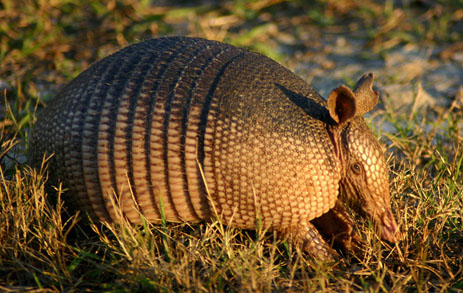 |
|||||||||||
|
|||||||||||
|
Dasypus novemcinctus Photo Fiona Sunquist © When the Spanish encountered these “shelled mammals” in the New World they gave them the name armadillo, meaning ‘little armored one’. Armadillos are nearly hairless and covered with armor-like plates, making them difficult to mistake for any other mammal. They weigh 3.6-7.7 kg (8-17 lbs) and move with a highly characteristic tiptoe trot – like a clockwork toy. Their tracks are birdlike, showing long middle toes and a line where the tail drags. When threatened they usually run or burrow quickly into the ground. Anyone who drives on Florida’s roads notices that armadillos and cars don’t seem to get along well – these cat-sized shelled mammals make up a disproportionate number of road kills. This holds true across the southern US, in Texas they are known as ‘Texas speed bumbs’. The problem lies with armadillo behavior. When an armadillo is startled by a predator it may jump three feet into the air – straight up. This reaction is usually enough to escape a fox or a bobcat, but when the predator is a car the results are not so favorable. The jump sends it crashing into the underside of the vehicle. If you want to avoid an armadillo on the road, drive around it. If you try to miss it by straddling it with your wheels, it will jump. The nine-banded armadillo was first observed in the US in 1849, when it was limited to the Rio Grande Valley in Texas. Aided by humans and its own capabilities, the armadillo has undergone an explosive range expansion in the last 150 years and the species is now found throughout the southern United States. Armadillos were deliberately introduced to Florida in the 1920’s and have spread throughout the state. This population has now merged with populations that expanded naturally eastward from Texas. Drought and extended periods of freezing temperatures are thought to be the factors that will ultimately limit the northern movement of armadillos. The nine-banded armadillo is an opportunistic species that thrives in citrus groves, cattle pastures, fields, gardens, logged forest, pine flatwoods and scrub habitats. It is most abundant in moist habitats, near water, and wherever deep sandy soils provide easy digging. Despite their armor plating, nine-banded Armadillos can swim well. More than 90% of an armadillo’s food consists of insects and other invertebrates, and they occasionally eat reptiles, amphibians, bird eggs, berries and fungi. They are great diggers and each animal excavates a series of underground dens throughout its home range. The burrows, which range from 3 to 16 feet deep, are usually located at the base of stumps, trees or under brush piles. Armadillos first breed when they are about a year old. They mate in July or August but the fertilized egg does not implant in the uterus until late November of December (this process is called delayed implantation). The single fertilized egg divides into four cells that separate and develop into four identical embryos. After a gestation period of about 120 days the female gives birth to identical quadruplets in March or April. The young begin to accompany their mother to find food when they are only a few weeks old, and become independent after about six months. Armadillos often irritate homeowners by digging up lawns, golf courses, vegetable gardens, and flowerbeds. They can also cause damage by burrowing under building foundations and driveways. Armadillos in Texas and Louisiana have tested positive for leprosy and have transmitted it to people. Armadillos in Florida do not seem to carry the disease; tests of 3000 animals showed no evidence of leprosy – however it is probably not a good idea to handle them.
|
| • Live weather radar • About Florida weather • Map & Key to Regions |

Wildlife of Florida 2011
Fiona Sunquist
Download $19.99


Wildlife of Florida: Lizards
Fiona Sunquist
Download $2.49

gator/crocs | birds | mammals | snakes | turtles | frogs/toads | lizards | sharks
Wildlife | Favorite Activities | My Destinations | about us | resources | site map | home
![]() web site development by Creative Communications
web site development by Creative Communications












